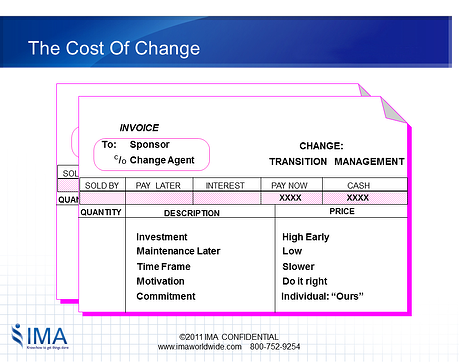Some organizational changes are compliance-driven; some are commitment driven; some have elements of both. Each approach has predictable outcomes, upsides, and downsides. One of the values of having a change management methodology that is tactical and operational is that you get guidance on how you need to implement differently, depending on the nature of your change. 
Differences Between Compliance-Driven and Commitment-Driven Changes
We categorize compliance-driven changes as "the hammer approach" because you have to "pound the change" in and make it happen. Compliance-driven changes like safety, regulatory requirements, downsizing, etc. are driven by necessity, not choice. The "hammer approach" isn't wrong and it is a misconception to think that it doesn't require organizational change management.
Even with compliance-driven changes, you must take into account the human element if you are going to be successful over the long-term. But more on that later.
Change Agents involved in commitment-driven changes should make aggressive use of communication and reinforcement to motivate people to leave. Remember the change management methodology principle that for these types of changes, the motivation to leave the present state must be greater than the motivation to stay where you are.
This means that you have to earn the commitment of Targets; but note that it is not about gaining consensus!
Change Agents and Sponsors should be clear about what type of change they are dealing with. Each type of change carries "costs" along with it--whether those costs are direct or in-direct:
Cost Comparison of Hammer Approach to Transition Management
|
|
Hammer Approach (Compliance) |
Transition Management (Commitment) |
|
|
Description |
Price |
|
Investment |
High Later |
High Early |
|
Cost to Maintain Long-Term |
High |
Low |
|
Time Frame to Complete |
Fast |
Slow |
|
Motivation |
Get It Done; Just Do It |
Do It Right |
|
Type of Commitment |
Organizational: “Theirs” |
Individual: “Ours” |
Advice for Change Agents and Sponsors
Since both the Hammer and Transition Management have upsides and downsides, it's helpful to be aware of the risks of each approach. 
If you are in a situation where it makes sense to use the hammer approach, be prepared for the fact that it requires a lot of energy and power. While on the surface it may seem like it is fast, understand that over time you will pay a price as resistance builds. So you may see an immediate increase in productivity and energy but that won't last. You pay for this type of approach, and it is usually "with interest."
Know, too, that the more often you use the hammer, the bigger the hammer you will need. In other words, over time, you have to increase the levels of "command and control" to generate the same impacts.
You also dampen innovation and creativity in this kind of environment because the hammer has a significant impact on risk-taking. So understand that there are "cultural costs" to this approach.
And one other word of advice: If you are going to use the hammer, don't try to mask it as a transition management approach to soften the blow. It's better to be truthful.
Managing Compliance-Based Changes
There are a lot of Change Agents and Sponsors that assume that there is no need for change management methodology application in a situation involving a compliance based change. Not true!
At a minimum you will still need to deal with the five "repeatable" steps in the Accelerating Implementation Change Management Methodology (AIM) process:
- Define the Change
- Generate Sponsorship
- Build Target Readiness
- Build a Communication Plan
- Develop a Reinforcement Strategy
Even if the hammer is used, you still must do it in an AIM way!
Move Faster
You can speed your implementation by doing the following:
1. Be clear about whether you want to drive compliance or build commitment for each Target Group. The method of implementation may not be the same for every Target Group!
2. Clearly understand the consequences of either choice, especially when it comes to outcomes, time frames and costs.
3. Be truthful once you make a decision on which approach makes sense. Don't try to soften the blow by "decorating" or "disguising" the hammer. You just risk losing credibility, and remember that trust and speed are functional.
4. When you need to build commitment, don't confuse commitment with consensus. It is not about having everyone agree to or like your change.
Think about the changes going on in your organization. Are you trying to use the hammer when you really need to use Transition Management?


